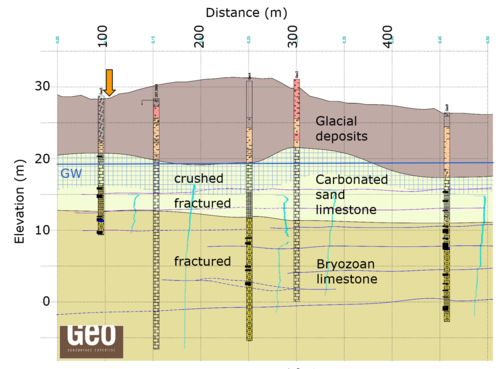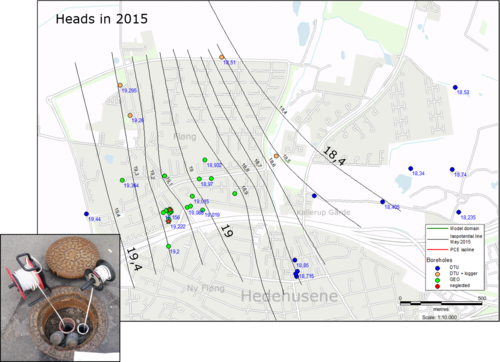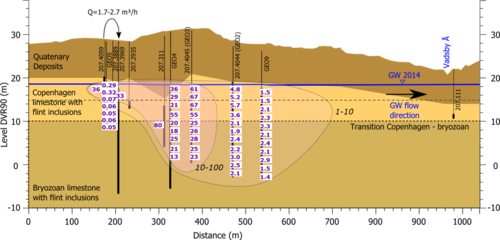Conceptual modeling
| Highlights |
|---|
|
ContentsConceptual model developmentThis chapter describes the development of a conceptual model for the Akacievej field site based on a set of field measurements and modeling. Geologic modelData from boreholes (drilling reports), borehole cores, geophysical measurements, larger-scale geologic maps and expert knowledge were combined to setup a 3D geologic model using the software GeoScene3D. The top of the limestone layer, the transition from crushed to fractured limestone and the transition from the København's kalk to bryozoan limestone were determined in an array of boreholes and the data was spatially interpolated to obtain 3D surfaces that can be used in a numerical flow and transport model. A cross section of the geologic model at the Akacievej site is shown in Figure 1 and described in the Chapter Geology and properties of limestone. Flow field and isopotential mapTo determine the potential migration pathways of contaminants, it is important to have knowledge of the local groundwater flow field. A good indication is given by the hydraulic head distribution in the area and an isopotential map. At the Akacievej site, several synchronous hydraulic head measurement campaigns were done to determine the hydraulic head distribution in the larger plume area and to assess the temporal variation of the flow field. Therefore, the hydraulic heads in the boreholes in a larger area around the Akacievej site were sounded on the same day using dipmeters. For the head measurements at the Akacievej site in 2015, the remediation system at the site and the wells of the Fløng waterworks were switched off in advance before measuring the heads. The measured heads were included in a geographic information system (GIS) and an isopotential map was created. It can be beneficial to include wells in an area larger than the area of immediate interest (e.g. plume), to get a good picture of the regional groundwater flow and to allow the choice of a model domain with little influence of the boundaries on the flow field in the area of interest. Figure 2 shows the isopotential map that was created for the area around the Akacievej field site in 2015. A new isopotential map was created in 2018. It showed only minor changes of the flow field since the sounding round in 2015, indicating stable flow conditions. The groundwater table was about 50 cm higher than in 2018, but this was relatively uniformly distributed in the investigated area. Determination of aquifer parametersA combination of methods was tested and used to determine aquifer parameters at the Akacievej site. The hydraulic conditions were investigated with a long-term pumping test, short-term pumping tests, packer tests and vacuum slug tests. This was complemented by head measurements at the remediation well and at the wells of neighboring waterworks during operation and while the pumps were switched off. Additional measurements included geophysical borehole logging with flow logs, gamma logs, caliper probes, density and porosity measurements and temperature probes. The remediation system was turned off and on several times while monitoring the head changes in the remediation well and in observation wells in the area with pressure transducers. Groundwater flow fields could be determined with and without remedial pumping. The pumping-test like event of switching the remediation well on and off yielded drawdown- and recovery curves and allowed to determine the hydraulic conductivity around the remediation well. The following report contains a detailed description of a long-term pumping test that was conducted at the Akacievej site in combination with six tracer tests and PCE measurements: To investigate the transport behavior in the aquifer, six tracer tests were completed in combination with the long-term pumping test at Akacievej in spring 2016. Model simulations guided the design of the tracer tests. Tracer was injected at four different screened wells, which have wells screens at different depths and in different geologic aquifer units. Contaminant distribution and dynamicsThe PCE concentrations at the Akacievej site were monitored in the pumped water from the remediation well (PB) since the installation of the remediation system. Additionally, several sampling rounds were done in the period from 2014-2016 and 2018 using different sampling techniques. The wells were also sampled under different conditions:
This showed strong dynamics of the PCE distribution in the aquifer - the pumping had a strong influence on the observed concentrations in the wells at Akacievej. The different depth-discrete sampling methods that were used at the Akacievej site (separation pumping, bladder pump, snap samplers, diffusion cells) are described in detail in the following report (in Danish): To improve the understanding of the contaminant dynamics in the greater source zone under different pumping conditions, a detailed 3D flow and transport model was setup in COMSOL Multiphysics. A discrete-fracture model was used to account for the interactions between major horizontal fractures and matrix. The horizontal fractures had been identified from flow logs in some of the wells in the area. A stationary flow model was setup and compared to the drawdown measurements from the remediation system and from the long-term pumping test. The fracture aperture and the hydraulic conductivity of the crushed limestone (where fractures were not resolved) were varied to match the observed drawdown in the wells. The hydraulic conductivity of the limestone matrix in the fractured limestone was obtained from hydraulic tests on subcores from the intact limestone matrix. The steady-state flow model served as basis for the transport models. The tracer tests allowed to estimate the limestone porosity and an effective diffusivity (the diffusivity had to be increased to account for neglected small fractures). Porosity and hydraulic conductivity measurements on limestone probes from borehole cores were done with steady-state gas permeameter and porosimeter (PoroPerm) tests. They were used for the hydraulic properties of the limestone matrix in the discrete-fracture model. To analyze the origin of PCE that was observed in the wells at the Akacievej site, the transport model was run on the inverse flow field. This method can be employed to analyze the volume, where substances are coming from to the different observation boreholes under pumped and non-pumped conditions. In 2018, the picture of the PCE distribution was updated by depth-specific measurements in the source- and plume area using a bladder pump. An updated map of the contaminant distribution was made and documented in the following report (in Danish): This served as input for combined 2D and 3D modeling of the plume dynamics, which are further described in the report and in this chapter . The detailed 3D model of the source zone, that was previously calibrated to the tracer tests, was employed to simulate the evolution of the contamination distribution and to estimate the contaminant flux out of the source zone. This contaminant flux was used as input for a plume-scale 2D model to investigate the long-term effects of the remediation system on the plume propagation. The model results showed possible effects of different remediation strategies and contributed to the re-evaluation of the remedial system at the Akacievej site.
|


